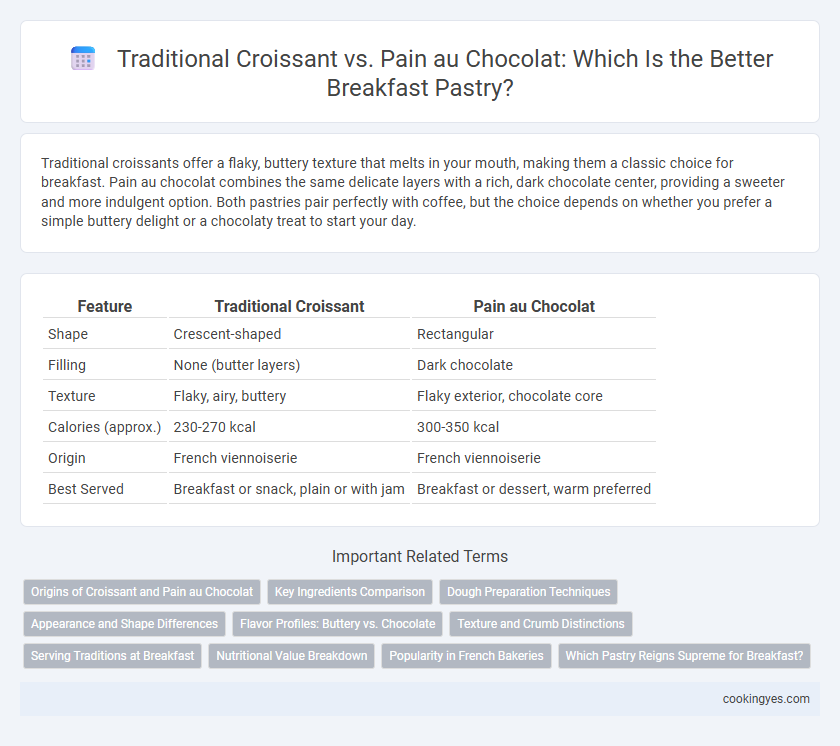Traditional croissants offer a flaky, buttery texture that melts in your mouth, making them a classic choice for breakfast. Pain au chocolat combines the same delicate layers with a rich, dark chocolate center, providing a sweeter and more indulgent option. Both pastries pair perfectly with coffee, but the choice depends on whether you prefer a simple buttery delight or a chocolaty treat to start your day.
Table of Comparison
| Feature | Traditional Croissant | Pain au Chocolat |
|---|---|---|
| Shape | Crescent-shaped | Rectangular |
| Filling | None (butter layers) | Dark chocolate |
| Texture | Flaky, airy, buttery | Flaky exterior, chocolate core |
| Calories (approx.) | 230-270 kcal | 300-350 kcal |
| Origin | French viennoiserie | French viennoiserie |
| Best Served | Breakfast or snack, plain or with jam | Breakfast or dessert, warm preferred |
Origins of Croissant and Pain au Chocolat
The traditional croissant has its origins linked to the Austrian kipferl, which was introduced to France in the 17th century, evolving into the flaky, buttery pastry known today. Pain au chocolat, also known as chocolatine in some regions, shares similar dough ingredients but is distinguished by a rectangular shape filled with dark chocolate, originating from French patisseries in the 19th century. Both pastries reflect distinct aspects of French baking heritage and are staples in classic French breakfast culture.
Key Ingredients Comparison
Traditional croissants feature a flaky, buttery dough made from flour, butter, sugar, yeast, and milk, emphasizing a light, airy texture. Pain au chocolat incorporates the same laminated dough but includes rich dark chocolate batons inserted before baking, providing a sweet, chocolaty filling. Both pastries rely on high-quality butter for lamination, but pain au chocolat offers an added layer of flavor complexity through its chocolate core.
Dough Preparation Techniques
Traditional croissants feature a laminated dough with multiple folds of butter and dough, creating a flaky texture achieved through precise temperature control and resting periods. Pain au chocolat dough shares this lamination process but often includes a slightly different shaping technique to encase chocolate batons securely. Both pastries rely on extensive dough resting and chilling to develop the signature airy layers essential for a delicate breakfast pastry experience.
Appearance and Shape Differences
The traditional croissant features a crescent shape with distinct, flaky layers and a golden-brown exterior, reflecting its buttery texture and lightness. In contrast, pain au chocolat has a rectangular, slightly elongated shape, often with visible chocolate sticks inside, and a similarly flaky, glossy crust. These appearance and shape differences influence the eating experience, with the croissant's curved form ideal for tearing and the pain au chocolat's compact shape containing rich, melted chocolate for a sweet, indulgent bite.
Flavor Profiles: Buttery vs. Chocolate
Traditional croissants feature a rich, buttery flavor with flaky layers that offer a delicate, slightly sweet taste, making them a classic breakfast choice. Pain au chocolat combines the buttery pastry texture with a luscious, bittersweet chocolate filling, providing a more indulgent option. The contrast between the subtle richness of the croissant and the intense cocoa notes of pain au chocolat defines their unique flavor profiles in morning pastries.
Texture and Crumb Distinctions
Traditional croissants are characterized by a flaky, layered texture with a light, airy crumb created through multiple laminations of butter and dough. Pain au chocolat features a slightly denser crumb and a more compact texture due to its rectangular shape and chocolate-filled center, resulting in a richer, more indulgent breakfast pastry. Both pastries share buttery layers, but croissants emphasize crispiness and flakiness, while pain au chocolat offers a tender bite with a smooth chocolate core.
Serving Traditions at Breakfast
Traditional croissants are often served plain or lightly buttered, highlighting their flaky texture and buttery flavor, making them a classic choice for French breakfast tables. Pain au chocolat, filled with rich dark chocolate, adds a sweet and indulgent option, frequently enjoyed alongside coffee or hot chocolate in boulangeries across France. Both pastries are staples of breakfast culture, with croissants emphasizing simplicity and pain au chocolat offering a decadent variation.
Nutritional Value Breakdown
Traditional croissants typically contain around 231 calories, 12g of fat, 26g of carbohydrates, and 4.5g of protein per 67g serving, providing moderate energy with a rich buttery flavor. Pain au chocolat, slightly higher in calories at approximately 300 per 70g serving, offers similar fat content but increased sugars and carbohydrates due to the chocolate filling, making it a sweeter breakfast option. Both pastries are rich in saturated fats and refined flour, but pain au chocolat delivers a higher sugar load, impacting overall nutritional value and glycemic response.
Popularity in French Bakeries
Traditional croissants remain the most popular breakfast pastry in French bakeries, celebrated for their flaky, buttery layers that embody classic French baking. Pain au chocolat, while also widely enjoyed, ranks just behind in popularity due to its rich chocolate filling offering a sweet variation. Both pastries are staples, but bakery sales data consistently show croissants leading in morning demand across France.
Which Pastry Reigns Supreme for Breakfast?
The traditional croissant, with its flaky, buttery layers and light, airy texture, offers a classic breakfast experience revered in French patisseries. Pain au chocolat, featuring the same laminated dough but enriched with rich, dark chocolate, satisfies a sweeter craving and provides a more indulgent start to the day. While croissants excel in subtlety and versatility, pain au chocolat reigns supreme for chocolate lovers seeking a decadent breakfast pastry.
Traditional croissant vs pain au chocolat for breakfast pastry Infographic

 cookingyes.com
cookingyes.com